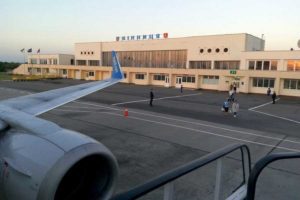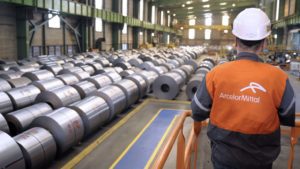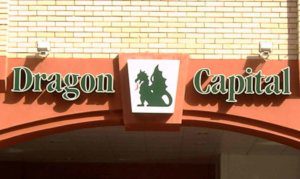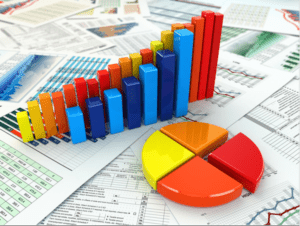
The State Agency for Infrastructure Projects jointly with Infrastructure Ministry has presented a plan on reconstruction of municipal enterprise Vinnytsia International Airport for 2019-2020. Head of the State Agency for Infrastructure Projects Mykola Bozhko said at a press conference in Kyiv on Tuesday that it is planned to spend UAH 2.2 billion on the reconstruction project, including UAH 1.013 billion in 2019 for the first phase of the project.
According to him, the airport modernization project was developed as part of the program to modernize regional airports and the public expertise of the project is now being completed, and the reconstruction of the Vinnytsia International Airport will begin soon. “We plan to launch the first flight by the end of this year,” he said.
The first part of the reconstruction project includes: reconstruction of the runway, partial reconstruction of the apron, lighting, radio and meteorological equipment, cable networks and engineering networks of power supply and communications.
“This will allow us to get a modern, highly optimized international complex. The project is divided into two phases, which will allow, after putting into operation the first phase, to receive a fully operational aerodrome complex, which will be able to accept all types of aircraft of class B, C and, in some cases class D (767-200, 767-300),” Bozhko said.
According to him, this will increase the number of passengers served. He also noted the great potential of the Vinnytsia airport for freight shipments.
According to Bozhko, radio equipment and means of radio navigation will be supplied at the expense of Ukraine’s State Air Traffic Services Enterprise (UkSATSE).

PJSC ArcelorMittal Kryvyi Rih (Dnipropetrovsk region) in 2018 increased its capital and operating expenses by 31.6% compared to 2017, to $443.4 million from $337 million.
According to a press release of the company, $348.8 million were capital investments, $94.6 million were operating costs.
In 2019, the company intends to invest more than $450 million.
At the same time, the press service clarifies that one of the key projects in 2018 is the construction of two new continuous casting machines worth about $144 million. Hot tests of one of the continuous casting machines will begin in February of this year. It is also planned to complete the reconstruction of small section mill No. 250-4 in spring, the volume of investments in it will be about $55 million.

The investment of the European Bank for Reconstruction and Development (EBRD) in the development of business projects in Ukraine will reach EUR 550 million by the end of 2018, EBRD Deputy Head for Ukraine Marina Petrov has said.
“Taking into account this transaction [a loan to the carrier Negabarit-Service], we will have about EUR 505 million in the deals signed in 2018, and we hope that we should reach EUR 550 million by the end of the year,” she said at a press conference in Kyiv.
Petrov also noted that the EBRD plans to increase investments by 20% if the rate of economic growth is maintained.
“The economic growth that started in Ukraine creates opportunities for new business investments. We hope that in 2019 we will do more business by at least 20%, and if the macroeconomic situation remains stable, we will try to do more,” she said.
According to her, the EBRD continues to consider Ukraine as one of the main countries among its customers.
“We are very positive about the prospects for next year’s projects,” she said.

President of the European Business Association (EBA) Tomas Fiala, his group of companies Dragon Capital and its employees contributed a total of UAH 22.6 million for charity and sponsorship purposes in 2018 to support Ukrainian projects for economic and social development, while in 2017 over UAH 10 million was sent for these purposes.
According to a press release of Dragon Capital issued last week, the Centre for Economic Strategy, an independent policy think tank, analytical platform VoxUkraine and its VoxCheck project, the New Leaders National Project, Anti-Corruption Action Centre, Transparency International and other NGOs working to support economic reforms, improve the business climate and help fight corruption in Ukraine together received close to UAH 12 million compared with UAH 6.1 million a year ago.
More than UAH 4.9 million was raised to finance the development of children’s hospital Ohmatdyt, help patients fighting cancer, buy a hemo-analyzer for the Western Ukrainian specialized children’s medical center (Lviv), support orphanages, repair a kindergarten, and sponsor the IWCK Charity Bazaar.
Last year Dragon Capital said in the report that the group contributed some UAH 1 million to Army SOS and IWCK Charity Bazaar. The group said that this year Dragon started to cooperate with Veteran Hub, Ukraine’s first open space for veterans of the war in eastern Ukraine and NGOs serving to protect their rights, as well as with other veteran associations in order to facilitate former soldiers’ social adaptation, particularly through employment.
According to the press release, over UAH 5.1 million went this year (UAH 3 million a year ago) to finance the Ukrainian Emerging Leaders Program at Stanford University, the Prometheus educational platform, the GoGlobal program aimed at promoting studies of foreign languages in Ukraine, the Ukrainian Academy of Leadership, etc.
According to the press release, Dragon Capital also donated UAH 0.6 million to support a public organization, whose mission is to preserve and promote the cultural, historical and archaeological heritage of Ukraine; the Lviv Media Forum, etc.
Dragon Capital group of companies, founded in 2000, is one of the largest in the Ukrainian investment market. Fiala said that in the past three years jointly with partners from the EU and the United States the group invested almost $500 million to Ukraine.

Capital investments in Ukraine in January-September 2018 increased by 19.9%, while in January-September 2017 by 20.7%, the State Statistics Service has reported. Capital investments in Ukraine in 2017 increased by 22.1%, in the first nine months of the year by 20.7% and in the first half of the previous year by 22.5%. According to the service, in January-September 2018 some UAH 337 billion of capital investments was used (excluding the temporarily occupied territory of Crimea, Sevastopol and Donbas).
In terms of regions, the largest increase in capital investments in January-September 2018 compared to the same period in 2017 was recorded in Donetsk (84.9%), Vinnytsia (42.4%), Dnipropetrovsk (34.6%), Chernihiv (33.1%), Rivne (28.1%), Zakarpattia (24.7%), Cherkasy (17%), Zhytomyr (12.6%), Volyn (12.4%), Chernivtsi (by 11.1%), Kharkiv (by 9.5%), Ternopil (by 8.4%), Poltava (8.3%), Odesa (8.2%), Lviv (7.2%), Kyiv (5.3%) and Sumy (3.3%) regions and Kyiv City (by 35.2%).
According to statistics, capital investment over the period fell in Mykolaiv (17.8%), Zaporizhia (16.7%), Khmelnytsky (9.5%), Kirovohrad (9%), Kherson (7.1%), Ivano-Frankivsk (3.9%), and Luhansk (3.1%) regions.
In terms of sectors, the growth of capital investments in January-September 2018 was recorded in postal and courier activities (a 2.7-fold rise), arts, sports and entertainment (a 2.1-fold rise), telecom (59.9%), aviation (55.3%), IT and telecom (53.8%), warehouses and auxiliary operations in the transport sphere (53.7%), retail trade (50.7%), programming and provision of other IT services (49.7%), forestry and logging (38.5%), wholesale and retail trade, repair of motor vehicles and motorcycles (37.14%), land and pipeline transport, as well as wholesale and retail trade (36%), financial and insurance activities (28.9%), publishing (28%), in the field of health care and social assistance (27.1%), industry (25.2%), public administration and defense, compulsory social insurance (24.6%), education (23.1%), agriculture, forestry and fisheries (7.7%).
The decline was seen in administrative and auxiliary servicing (18.9%), water transport (15%) and construction (10.8%).
Own funds of enterprises and organizations remain the main source of financing of capital investments, which account for 73.2% of the total volume of all investments.
A significant share of capital investments was made in machinery, equipment and vehicles – 47.2%, buildings and structures – 42.8% of all investments.